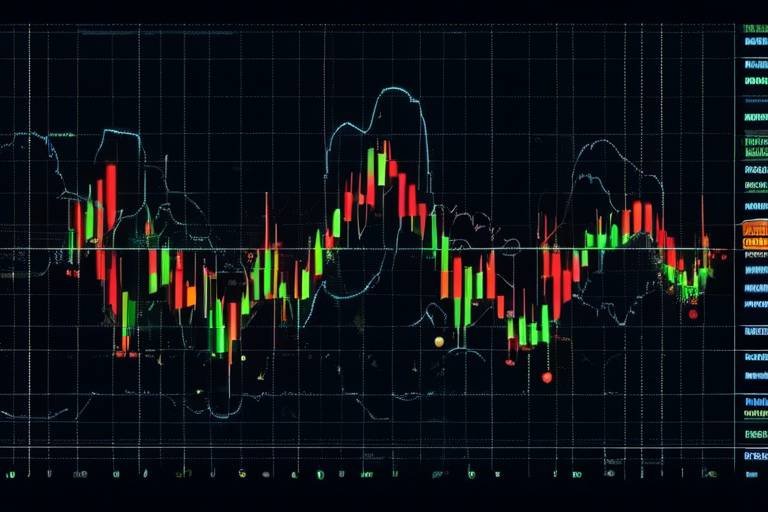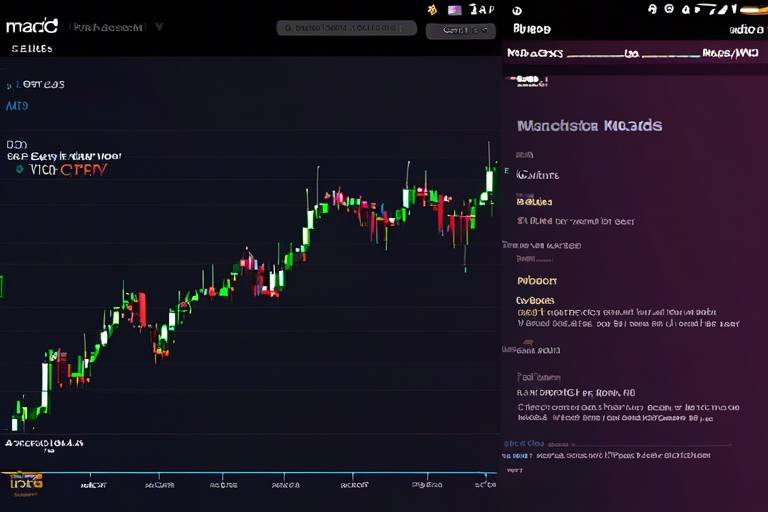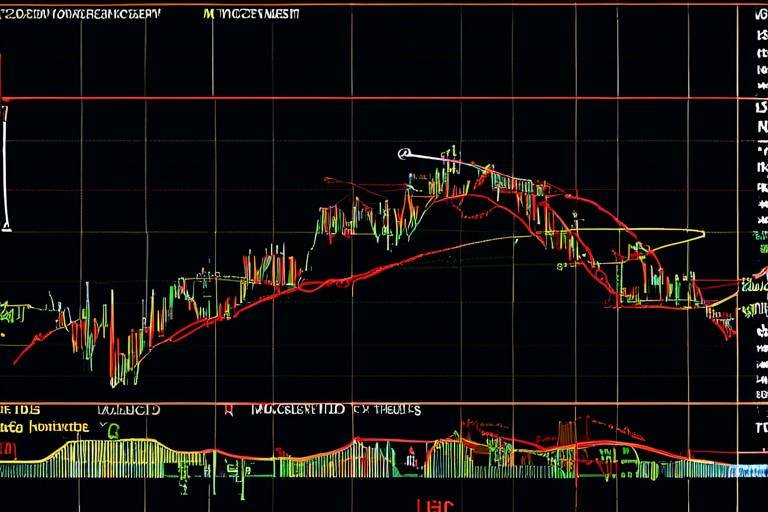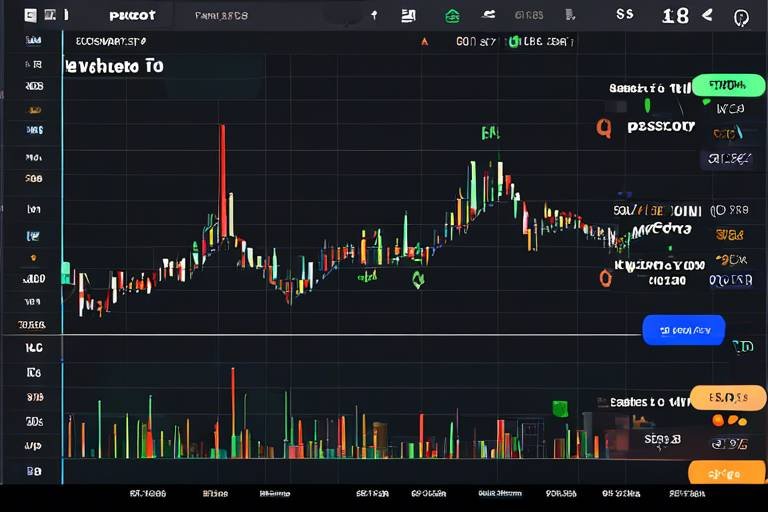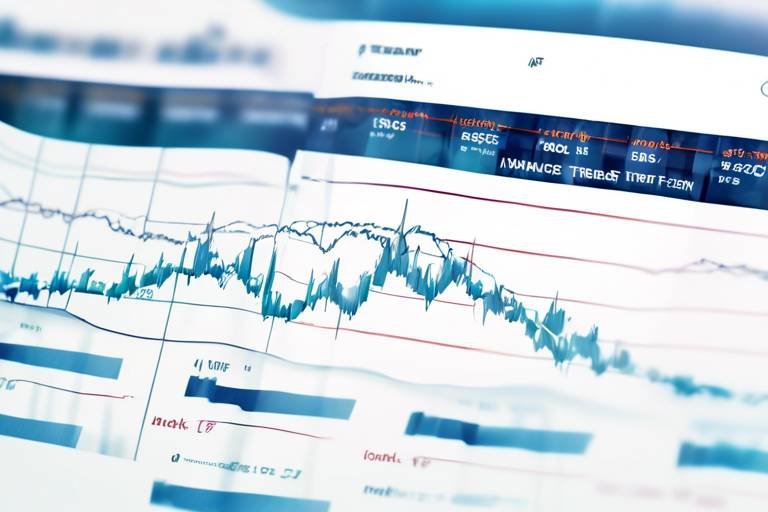How to Utilize Divergence in Technical Analysis
Divergence in technical analysis is like a secret code that traders can use to unlock the mysteries of price movements in the financial markets. It’s a fascinating concept that occurs when the price of an asset moves in the opposite direction of an indicator, such as the Relative Strength Index (RSI) or Moving Average Convergence Divergence (MACD). Understanding divergence is crucial for traders looking to enhance their decision-making processes, as it can provide valuable insights into potential market reversals or continuations. But why should you care about divergence? Well, recognizing these patterns can be the difference between a profitable trade and a costly mistake. Imagine standing at a crossroads, with one path leading to profit and the other to loss. Divergence is your compass, guiding you toward the right choice.
At its core, divergence is all about the relationship between price and indicators. When these two elements diverge, it signals that something significant is happening beneath the surface. For instance, if the price of an asset is making new highs, but your indicator is failing to follow suit, this could be a warning sign that the upward momentum is weakening. Conversely, if prices are making new lows while indicators show strength, it might indicate an impending bullish reversal. Recognizing these patterns is essential for traders, as they can provide critical insights into market sentiment and potential price movements. Think of divergence as a whisper from the market, urging you to pay attention to what’s really going on. Ignoring these whispers can lead to missed opportunities or, worse, significant losses.
Divergence can be categorized into two primary types: regular and hidden. Each type serves a different purpose and signals different market conditions. Regular divergence is often associated with potential trend reversals, while hidden divergence suggests that the current trend is likely to continue. Understanding the characteristics of both types is essential for any trader looking to make informed decisions. Regular divergence can be seen as a red flag, while hidden divergence is more like a green light, indicating that the current trend still has legs. By familiarizing yourself with these types, you can better position yourself in the market and capitalize on potential opportunities.
Regular divergence is a clear indication that a trend reversal may be on the horizon. It occurs when the price action and the indicator are moving in opposite directions. For traders, identifying regular divergence is crucial, as it can provide early signals to enter or exit trades. This type of divergence can manifest in two forms: bearish and bullish. Understanding how to spot these signals can dramatically improve your trading strategy.
Bearish regular divergence occurs when prices reach new highs, but the indicator fails to do so. This situation can be likened to a balloon that’s inflated to its maximum size but is starting to show signs of weakness. Traders should be cautious, as this divergence often signals that the bullish momentum is waning, and a price correction may be imminent. Spotting this signal can open the door to short-selling opportunities, allowing traders to capitalize on the impending downturn. To identify bearish regular divergence, look for:
- Price making higher highs
- Indicator making lower highs
Bullish regular divergence, on the other hand, occurs when prices hit new lows while the indicators show signs of strength. It’s like seeing a flower bloom in the midst of a harsh winter; it suggests that despite the challenging conditions, there’s potential for growth and recovery. This type of divergence can be a strong signal for traders looking to enter long positions. To identify bullish regular divergence, look for:
- Price making lower lows
- Indicator making higher lows
Hidden divergence is a different beast altogether. Instead of signaling a trend reversal, it suggests that the current trend is likely to continue. This type of divergence can be particularly useful for traders who want to confirm their positions and ride the trend. Identifying hidden divergence requires a keen eye, as it often occurs during price retracements. Recognizing this pattern can help traders maintain their positions and avoid premature exits, ensuring they capture the full potential of their trades.
Understanding how to apply divergence in trading is crucial for success. By integrating divergence into your trading plan, you can enhance your decision-making process and improve your overall trading performance. One effective way to do this is by combining divergence with other technical indicators. This synergy can provide a more comprehensive view of market conditions, allowing for more informed trading decisions.
Combining divergence with other technical indicators can significantly enhance your trading effectiveness. For instance, using divergence alongside moving averages can help confirm potential trend reversals. When both the price action and the moving average align with the divergence signal, it creates a stronger case for entering or exiting a trade. Similarly, incorporating RSI can provide additional context to the divergence signals, helping traders make more informed decisions. This layered approach to analysis can be likened to having multiple tools in your toolbox; the more tools you have, the better equipped you are to tackle any situation.
Incorporating risk management strategies when trading divergence is essential. While divergence can provide valuable signals, it’s crucial to remember that no indicator is foolproof. Implementing stop-loss orders and position sizing can help mitigate risks associated with trading signals derived from divergence analysis. By managing your risk effectively, you can protect your capital and ensure that a few losing trades won’t derail your overall trading strategy. Think of risk management as your safety net; it allows you to take calculated risks while safeguarding your investments.
What is divergence in technical analysis?
Divergence occurs when the price of an asset moves in the opposite direction of an indicator, signaling potential market reversals or continuations.
How can I identify regular divergence?
Regular divergence can be identified by comparing price action and indicators; look for instances where prices make new highs or lows while indicators fail to do the same.
What is the difference between regular and hidden divergence?
Regular divergence signals potential trend reversals, while hidden divergence indicates that the current trend is likely to continue.
How can I use divergence with other indicators?
Combining divergence with other indicators like moving averages or RSI can provide additional confirmation for trading signals, enhancing decision-making.
Why is risk management important when trading divergence?
Risk management is crucial to protect your capital and ensure that losses from a few trades do not significantly impact your overall trading strategy.

Understanding Divergence
Divergence is a pivotal concept in the realm of technical analysis, acting as a signal that can guide traders in making informed decisions. At its core, divergence occurs when the price of an asset moves in a direction that contradicts the movement of an indicator, often hinting at potential reversals or continuations in market trends. Imagine you're watching a car race; if one car speeds up while the others slow down, that could be a sign something's about to change. Similarly, divergence can indicate that the momentum behind a price move is weakening, which is crucial information for traders.
Recognizing divergence is essential for any trader looking to enhance their strategies. It allows them to spot discrepancies between price action and momentum indicators, such as the Relative Strength Index (RSI) or Moving Average Convergence Divergence (MACD). When these indicators fail to confirm the price movement, it raises a red flag. For example, if the price of a stock is climbing higher but the RSI is trending downward, that suggests the upward momentum may be losing steam. This disconnect can serve as a warning that the current trend might not be sustainable.
There are two primary types of divergence: regular and hidden. Regular divergence is typically associated with potential trend reversals, while hidden divergence indicates trend continuation. Understanding these nuances can significantly impact trading outcomes. In practical terms, recognizing divergence can help traders avoid entering positions that appear favorable but are actually built on shaky ground. Just like a house of cards, if the foundation isn’t solid, the whole structure can come tumbling down.
Moreover, incorporating divergence into your trading strategy can lead to more robust decision-making. By being aware of these signals, traders can better manage their entries and exits, aligning their trades with the underlying market momentum. This is not just about spotting opportunities; it’s also about protecting oneself from potential losses. The beauty of divergence lies in its ability to provide clarity in a chaotic market landscape, allowing traders to navigate their way through uncertainty with confidence.
In summary, understanding divergence is not just an academic exercise; it's a practical tool that can enhance your trading strategy. By paying attention to the relationship between price action and momentum indicators, traders can gain valuable insights that help them make more informed decisions. So, the next time you analyze market movements, remember to look for those divergence signals—they might just be the key to unlocking your trading potential.

Types of Divergence
Divergence is a fascinating concept in technical analysis that can greatly influence trading decisions. It essentially serves as a warning signal, alerting traders to potential shifts in market dynamics. There are two primary types of divergence that traders should be aware of: regular divergence and hidden divergence. Each type has its own characteristics and implications, which can be crucial for making informed trading choices.
Regular divergence is often seen as the more straightforward of the two types. It occurs when the price of an asset moves in one direction while an indicator moves in the opposite direction. This scenario can signal a potential trend reversal, making it essential for traders to recognize. For instance, if a stock is hitting new highs but the corresponding momentum indicator is failing to do the same, this could indicate a bearish regular divergence. Conversely, if the price is making new lows while the indicator shows signs of strength, this is a bullish regular divergence. Understanding these signals can empower traders to make strategic decisions that capitalize on market reversals.
On the other hand, hidden divergence suggests that the existing trend is likely to continue rather than reverse. This type of divergence can be a bit trickier to identify but is equally important. Hidden divergence occurs when the price makes a higher low in an uptrend while the indicator shows a lower low, indicating that the upward momentum is still intact. Similarly, in a downtrend, if the price makes a lower high while the indicator shows a higher high, it can suggest that the downward trend is likely to persist. Recognizing these patterns can help traders stay aligned with the prevailing market trends, allowing them to ride the wave rather than get caught in a reversal.
To summarize, understanding the different types of divergence is crucial for any trader looking to enhance their decision-making process. Regular divergence signals potential reversals, while hidden divergence indicates trend continuation. By mastering these concepts, traders can better navigate the often turbulent waters of financial markets.
In the following sections, we will delve deeper into each type of divergence, exploring their characteristics, how to identify them, and the practical implications they have for trading strategies.
- What is the main difference between regular and hidden divergence? Regular divergence signals potential trend reversals, while hidden divergence suggests that the existing trend is likely to continue.
- How can I identify regular divergence? Look for instances where the price reaches new highs or lows while the corresponding indicator fails to do so.
- Is hidden divergence easy to spot? It can be trickier to identify compared to regular divergence, but it's essential for confirming existing trends.

Regular Divergence
Regular divergence is a powerful concept in technical analysis that can signal potential trend reversals in the market. It occurs when the price of an asset moves in one direction while an indicator, such as the Relative Strength Index (RSI) or Moving Average Convergence Divergence (MACD), moves in the opposite direction. This dissonance between price action and indicators can be a telltale sign that the current trend is losing momentum, making it essential for traders to recognize and act upon these signals. Think of it like a tug-of-war: if one side is pulling harder but the other side is not yielding, something has to give!
Identifying regular divergence can significantly enhance your trading strategy. There are two primary types of regular divergence: bearish and bullish. Each serves as a clue to potential market reversals, and understanding how to spot them can be the difference between a profitable trade and a costly mistake. Let’s dive deeper into each type.
Bearish regular divergence occurs when the price of an asset reaches new highs, but the indicator fails to do the same. This situation suggests that while buyers are pushing prices up, the underlying momentum is weakening. It's like a runner sprinting to the finish line but slowing down just before crossing it. Traders often interpret this as a sign that the upward trend may be coming to an end, presenting an opportunity for short-selling. To spot this divergence, look for:
- Higher highs in price action.
- Lower highs in the corresponding indicator.
When you see this pattern, it’s crucial to consider entering a short position or tightening your stop-loss on long positions. The significance of this signal cannot be overstated, as it often precedes substantial price corrections.
On the flip side, bullish regular divergence occurs when prices hit new lows while the indicator shows strength by forming higher lows. This situation indicates that even though the price is declining, the selling pressure is weakening, hinting at a potential reversal to the upside. Imagine a coiled spring ready to bounce back; that's the market's potential when bullish divergence is present. To identify this divergence, look for:
- Lower lows in price action.
- Higher lows in the corresponding indicator.
Recognizing this pattern can provide traders with a fantastic buying opportunity. It’s a signal that the market may soon turn around, and savvy traders can capitalize on this by entering long positions before the trend shifts.
In summary, regular divergence is a crucial tool in a trader's toolkit. By understanding both bearish and bullish divergence, you can better anticipate market moves and make informed decisions. Always remember that while divergence can provide valuable insights, it should be used in conjunction with other technical analysis tools and risk management strategies to maximize your trading effectiveness.

Bearish Regular Divergence
Bearish regular divergence is a powerful signal that traders should be on the lookout for, as it often indicates a potential reversal in the market. This phenomenon occurs when the price of an asset reaches new highs, but the corresponding technical indicator, such as the Relative Strength Index (RSI) or the Moving Average Convergence Divergence (MACD), fails to follow suit. In simpler terms, while the price is climbing, the momentum behind that climb is weakening, which can be a red flag for savvy traders.
So, how can you spot bearish regular divergence in action? First, you want to identify a situation where the price makes a higher high. This is the first part of the equation. Next, you’ll need to check your chosen indicator to see if it has made a corresponding higher high. If it hasn’t—if it’s either flat or has made a lower high—then you’ve got yourself a bearish divergence setup. This discrepancy between price and indicator signals that the upward momentum is not sustainable and that a price correction may be imminent.
The significance of recognizing this divergence cannot be overstated. It acts as an early warning system, alerting traders to potential short-selling opportunities. For example, imagine you’re watching a stock that has surged to new heights, but your RSI is showing lower highs. This could be your cue to consider entering a short position or at least tightening your stop-loss orders. It’s like seeing a storm cloud on the horizon while you’re out sailing; it’s a sign to prepare for choppy waters ahead!
To illustrate this concept further, let’s break down a hypothetical scenario:
| Price Action | RSI Indicator | Signal |
|---|---|---|
| New High at $100 | New High at 70 | No Divergence |
| New High at $105 | Lower High at 65 | Bearish Divergence Detected |
In the table above, you can see how the price made a new high while the RSI showed a lower high. This sets the stage for a potential downward movement. Once you identify this divergence, it’s crucial to combine it with other forms of analysis to confirm your trading decision. Remember, no signal is foolproof, so it’s always wise to have a backup plan!
In conclusion, bearish regular divergence is a critical concept that every trader should master. By understanding how to identify this signal, you can position yourself to capitalize on potential market reversals. It’s not just about spotting the divergence; it’s about interpreting what it means for your trading strategy. So, the next time you see price making new highs while your indicators lag behind, take a moment to consider your options. Are you ready to ride the wave of opportunity, or will you let it pass by?

Bullish Regular Divergence
Bullish regular divergence is a powerful signal that traders eagerly watch for, as it indicates a potential reversal in a downtrend. Imagine you're on a roller coaster, and just as you're about to plunge down, you notice the ride is slowing down. That’s the essence of bullish divergence—prices are hitting new lows, but the underlying indicators, such as the Relative Strength Index (RSI) or Moving Average Convergence Divergence (MACD), are showing signs of strength. This divergence suggests that the market may be losing its bearish momentum, and a bounce back could be on the horizon.
To identify bullish regular divergence, traders typically look for the following characteristics:
- Price Action: The price makes a lower low.
- Indicator Behavior: The indicator, like RSI, makes a higher low.
When these two aspects align, it’s like finding a hidden gem in a pile of rocks. It’s essential to act cautiously and confirm this signal with other indicators or patterns before making a trading decision. For instance, you might notice that the price of a stock has dipped to $50, while the RSI has climbed from 30 to 35. This discrepancy is a red flag that the bearish sentiment might be waning, hinting at a potential buying opportunity.
But why should traders care about bullish divergence? The answer lies in its ability to provide early signals of reversals, allowing traders to enter positions before significant price movements. Think of it as a lighthouse guiding you through a foggy night. By recognizing these patterns, traders can position themselves advantageously, potentially leading to profitable trades.
It’s also crucial to remember that bullish regular divergence doesn’t guarantee a price reversal; rather, it increases the probability of one occurring. Therefore, incorporating additional analysis and risk management strategies is essential. For example, using stop-loss orders can protect against unexpected market movements, ensuring that you don’t get caught in a sudden downturn.
In summary, bullish regular divergence is an invaluable tool in a trader's arsenal. By understanding how to spot this phenomenon and using it in conjunction with other indicators and sound risk management practices, traders can enhance their decision-making processes and potentially increase their profitability in the financial markets.

Hidden Divergence
Divergence isn’t just about spotting potential reversals; it can also signal that the current trend is likely to continue. This is where comes into play. Unlike regular divergence, which hints at a possible change in direction, hidden divergence suggests that the existing trend still has momentum. Think of it as a train barreling down the tracks—just because you see a few loose bolts doesn’t mean it’s going to derail. Instead, it’s more about understanding that the train is still on its path, picking up speed.
So, how do you identify hidden divergence? It’s all about the relationship between price movements and your chosen indicators. When prices make a higher low in an uptrend, but the indicator (like the Relative Strength Index or RSI) makes a lower low, that’s a classic sign of hidden divergence. This scenario indicates that even though the price is pulling back, the underlying strength is still intact, and the trend is likely to continue. Conversely, in a downtrend, if prices make a lower high while the indicator shows a higher high, it’s another signal of hidden divergence, suggesting that the downward trend is still strong.
Recognizing hidden divergence can be a game-changer for traders. It allows them to stay in trades longer, capitalizing on trends instead of prematurely exiting due to minor pullbacks. For instance, imagine you’re on a roller coaster—just because you dip down a bit doesn’t mean the ride is over. Understanding hidden divergence helps traders remain in their seats, waiting for the thrilling upswing that’s still ahead.
To effectively utilize hidden divergence, it’s essential to combine it with other technical analysis tools. For example, using moving averages alongside hidden divergence can provide a clearer picture of trend strength. When both indicators align, it can create a powerful confirmation signal for traders. However, just like in any other aspect of trading, it’s crucial to manage your risks. Even with hidden divergence, unexpected market conditions can arise, so having a safety net in place is always wise.
In summary, hidden divergence serves as a reminder that trends can have deeper roots than they appear on the surface. By honing your ability to identify this phenomenon, you can enhance your trading strategy and improve your chances of riding the waves of market trends successfully.
- What is hidden divergence? Hidden divergence occurs when the price makes a higher low in an uptrend or a lower high in a downtrend, while the indicator shows the opposite, suggesting trend continuation.
- How can I spot hidden divergence? Look for discrepancies between price movements and your chosen indicators, such as RSI or MACD, during established trends.
- Why is hidden divergence important? It helps traders identify when to stay in a trade rather than exit prematurely during minor pullbacks, allowing them to maximize potential profits.
- Can hidden divergence be used with other indicators? Absolutely! Combining hidden divergence with tools like moving averages can provide stronger confirmation signals for traders.

Practical Applications of Divergence
Divergence is not just a theoretical concept; it's a powerful tool that traders can use to make informed decisions in the financial markets. By understanding how to apply divergence effectively, traders can enhance their strategies and potentially increase their profitability. Imagine you're on a road trip, and your GPS shows a different route than the one you're taking. Divergence acts like that GPS, helping you navigate through the sometimes confusing paths of market movements. So, how can you effectively utilize divergence in your trading?
One practical application of divergence is to identify potential entry and exit points in the market. For instance, when you spot a bearish regular divergence, where prices are making new highs but your momentum indicators are failing to keep up, it could signal a potential reversal. This is akin to a car speeding towards a cliff; the indicators are your brakes, telling you to slow down before it's too late. Conversely, a bullish regular divergence can indicate a buying opportunity when prices are hitting new lows while indicators show signs of strength. This is like finding a hidden gem in a junkyard—sometimes the best opportunities are right under your nose.
To illustrate these concepts, let’s take a look at a simple table that summarizes how divergence can signal different trading actions:
| Divergence Type | Market Condition | Action |
|---|---|---|
| Bearish Regular Divergence | Price makes new highs, indicators do not | Consider selling or shorting |
| Bullish Regular Divergence | Price makes new lows, indicators show strength | Consider buying |
| Hidden Divergence | Price makes a higher low, indicators make a lower low | Look for continuation in the trend |
Another essential aspect of applying divergence in trading is combining it with other indicators. For example, using divergence in conjunction with the Relative Strength Index (RSI) or Moving Averages can provide a more comprehensive view of market conditions. Think of it as having a multi-tool for your road trip; each tool offers a different perspective, helping you make better decisions. When divergence signals align with other indicators, it strengthens the case for your trading actions. This synergy can lead to more confident trading decisions.
Moreover, incorporating risk management strategies while trading divergence is crucial. Traders should never rely solely on divergence signals without considering the potential risks involved. It's like having a safety net when you’re walking a tightrope—always be prepared for the unexpected. Techniques such as setting stop-loss orders and position sizing can help mitigate risks associated with divergence analysis. By doing so, traders can protect their capital while still taking advantage of the opportunities that divergence presents.
In summary, understanding the practical applications of divergence in trading can significantly enhance your decision-making process. By identifying entry and exit points, combining divergence with other indicators, and implementing robust risk management strategies, you can navigate the complexities of the financial markets with greater confidence. Remember, divergence isn't just a signal; it's your guide through the unpredictable terrain of trading.
What is divergence in trading?
Divergence occurs when the price of an asset moves in the opposite direction of an indicator, signaling potential trend reversals or continuations.
How can I identify regular divergence?
Regular divergence can be identified by comparing price action with momentum indicators. Look for instances where price makes new highs or lows while the indicators do not follow suit.
What is the difference between regular and hidden divergence?
Regular divergence indicates potential trend reversals, while hidden divergence suggests trend continuation. Regular divergence is often used for entry and exit points, whereas hidden divergence confirms existing trends.
Can I use divergence with other indicators?
Absolutely! Combining divergence with other technical indicators like RSI or Moving Averages can enhance your trading effectiveness and provide a more complete market picture.
How do I manage risks when trading divergence?
Incorporating risk management strategies such as setting stop-loss orders and proper position sizing is essential to protect your capital while trading based on divergence signals.

Using Divergence with Other Indicators
When it comes to trading, relying solely on one indicator can be like trying to navigate a ship with just one sail; it might get you somewhere, but it won't be the most efficient route. This is where the power of divergence shines when combined with other technical indicators. By integrating divergence with tools like Moving Averages, Relative Strength Index (RSI), and MACD, traders can enhance their decision-making process and increase their chances of success.
For instance, consider how divergence can be identified alongside the RSI. The RSI is a momentum oscillator that measures the speed and change of price movements. When a trader notices bullish divergence on the RSI while the price is making new lows, it can signal a potential buying opportunity. Conversely, if there is bearish divergence while the price reaches new highs, it may indicate a chance to short the asset. This interplay between price action and momentum indicators can provide a clearer picture of market sentiment.
Moreover, using divergence with Moving Averages can help traders identify the strength of a trend. For example, if the price is trending upwards and the moving average is also moving in the same direction, but divergence appears, it could be a sign that the trend is losing momentum. This could prompt traders to tighten their stop-loss orders or even consider exiting their positions. It’s essential to recognize that while divergence may indicate a potential reversal or continuation, it is not a standalone signal. It should always be used in conjunction with other indicators for confirmation.
To illustrate this further, let’s take a look at a simple table that summarizes how divergence can be paired with other indicators:
| Indicator | Type of Divergence | Trading Signal |
|---|---|---|
| RSI | Bullish | Possible buying opportunity when price makes new lows |
| RSI | Bearish | Possible short-selling opportunity when price makes new highs |
| Moving Averages | Bullish | Trend continuation signal when price is above the moving average |
| Moving Averages | Bearish | Trend reversal signal when price is below the moving average |
In addition, the MACD (Moving Average Convergence Divergence) is another powerful tool that can be utilized alongside divergence. The MACD provides insights into the strength and direction of a trend. When divergence is spotted, traders should look at the MACD histogram for confirmation. If the histogram is also showing signs of weakening momentum, it can reinforce the potential for a trend reversal. This layered approach to analysis can significantly improve the accuracy of trading decisions.
Ultimately, the key takeaway is that while divergence is a potent signal in technical analysis, it becomes even more effective when used in conjunction with other indicators. By creating a multi-faceted approach to trading, you can better navigate the complexities of the financial markets. So, next time you analyze a price chart, remember to look beyond just divergence and consider how it interacts with other indicators. This holistic view can be your compass in the unpredictable seas of trading!

Risk Management with Divergence
When it comes to trading, understanding risk management is just as vital as knowing how to identify divergence. After all, even the most promising trading signals can lead to losses if not managed properly. So, how do you effectively incorporate risk management strategies when utilizing divergence in your trading plan? Let’s break it down.
First off, one of the key principles of risk management is to determine your risk tolerance. This is the level of risk you are comfortable taking on each trade. For instance, if you’re a conservative trader, you might decide to risk only 1% of your trading capital on a single trade. On the other hand, more aggressive traders might be comfortable risking up to 3% or more. Knowing your risk tolerance helps you set appropriate stop-loss levels, which are critical when trading on signals derived from divergence.
Next, consider using a risk-reward ratio to evaluate potential trades. This ratio helps you assess whether the potential reward of a trade justifies the risk involved. A common approach is to aim for a risk-reward ratio of at least 1:2, meaning for every dollar you risk, you aim to make two dollars. When trading divergence signals, you can establish your entry and exit points based on these ratios. For example, if you identify a bullish divergence and decide to enter a trade, you might set your stop-loss just below the recent low and your take-profit at a level that reflects a favorable risk-reward ratio.
Another essential aspect of risk management is position sizing. This refers to the number of units you buy or sell in a trade. Proper position sizing can significantly impact your overall risk exposure. A common formula for determining your position size is:
Position Size (Account Risk * Account Balance) / Trade Risk
By calculating your position size based on your account risk and the specific trade risk, you can ensure that you don’t overexpose yourself to any single trade.
Moreover, it’s crucial to remain disciplined and stick to your trading plan. Emotional trading can lead to poor decisions and increased risk. Always remember that even the most reliable divergence signals can fail. Therefore, having a well-defined plan that includes entry and exit strategies, along with risk management protocols, is your best defense against unpredictable market movements.
To summarize, integrating risk management with divergence trading involves:
- Assessing your risk tolerance to set appropriate stop-loss levels.
- Utilizing a favorable risk-reward ratio to evaluate potential trades.
- Calculating position sizes to manage exposure effectively.
- Maintaining discipline and adhering to your trading plan.
By following these guidelines, you can enhance your trading strategy and navigate the markets with greater confidence.
Q1: What is divergence in technical analysis?
A1: Divergence occurs when the price of an asset moves in the opposite direction of an indicator, signaling potential trend reversals or continuations.
Q2: How can I identify regular divergence?
A2: Regular divergence can be identified when price makes a new high or low, but the corresponding indicator does not. This discrepancy suggests a potential reversal.
Q3: What are the risks associated with trading divergence?
A3: The primary risks include false signals, market volatility, and emotional decision-making. Implementing risk management strategies can help mitigate these risks.
Q4: How can I combine divergence with other indicators?
A4: You can enhance your trading strategy by using divergence alongside indicators like moving averages and the Relative Strength Index (RSI) to confirm signals and improve decision-making.
Q5: Is it essential to have a risk management strategy?
A5: Absolutely! A solid risk management strategy is crucial for protecting your capital and ensuring long-term success in trading.
Frequently Asked Questions
- What is divergence in technical analysis?
Divergence in technical analysis refers to a situation where the price of an asset moves in the opposite direction of an indicator, such as an oscillator. This phenomenon can signal potential reversals or continuations in market trends, making it a valuable tool for traders looking to enhance their strategies.
- What are the types of divergence?
There are two main types of divergence: regular divergence and hidden divergence. Regular divergence indicates potential trend reversals, while hidden divergence suggests that the current trend is likely to continue. Understanding these types can significantly aid traders in making informed decisions.
- How can I identify regular divergence?
To identify regular divergence, look for instances where the price reaches new highs or lows, but the indicator fails to follow suit. For example, in a bearish regular divergence, prices hit new highs while the indicator shows lower highs, indicating a potential reversal. Conversely, in bullish regular divergence, prices make new lows while the indicator shows higher lows, suggesting a buying opportunity.
- What is the significance of hidden divergence?
Hidden divergence is crucial for confirming existing trends. It occurs when the price makes higher lows in an uptrend while the indicator makes lower lows, reinforcing the strength of the trend. Recognizing hidden divergence can help traders stay in profitable trades longer, as it suggests that the trend is likely to continue.
- Can I use divergence with other indicators?
Absolutely! Combining divergence with other technical indicators, such as moving averages or the Relative Strength Index (RSI), can enhance your trading effectiveness. For instance, if divergence signals a potential reversal and is confirmed by a moving average crossover, it can provide a stronger basis for your trading decision.
- How do I manage risks when trading divergence?
Risk management is essential when trading divergence. Traders should consider setting stop-loss orders to limit potential losses and use position sizing techniques to ensure that no single trade significantly impacts their overall portfolio. Additionally, always analyze market conditions and use multiple indicators to confirm signals before entering a trade.



